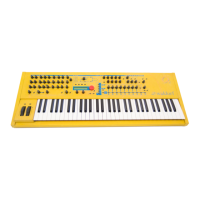Sound Parameters – Oscillators
Waldorf Q User’s Manual 68
The Square Wave
The Square Wave is a special waveform generated by a pulse waveform with 50% pulse width. This
means that the positive part of the waveform has equal length to the negative part. The pulse
waveform can have other pulse widths as you can read later. For now, we speak about the square
wave as a unique waveform. The square wave consists of all odd harmonics where the magnitude of
each harmonic descends by the factor of its position. This means that the first harmonic has full
magnitude, the third harmonic has a third magnitude, the fifth harmonic has a fifth magnitude and so
on. The following picture shows how the individual harmonics build up the sawtooth wave:
13
579
Frequency
Magnitude
Time
Amplitude
+
=
1st Harmonic
Magnitude 1
5th Harmonic
Magnitude 1/5
7th Harmonic
Magnitude 1/7
Harmonics
+
+
+
.
.
11 13 15
3rd Harmonic
Magnitude 1/3
Picture 12: Additive components of the square wave with 50% pulse width
The square wave was thought as an abstraction of wind instruments like a panflute or a recorder.
They consist of a tube that can contain a certain amount of air. The player blows air through the tube
in a way that the air starts to vibrate. This vibration is almost completely symmetrical resulting in a
hollow timbre.

